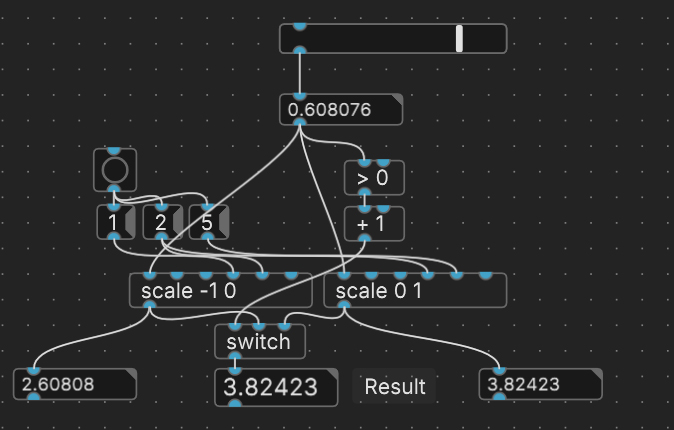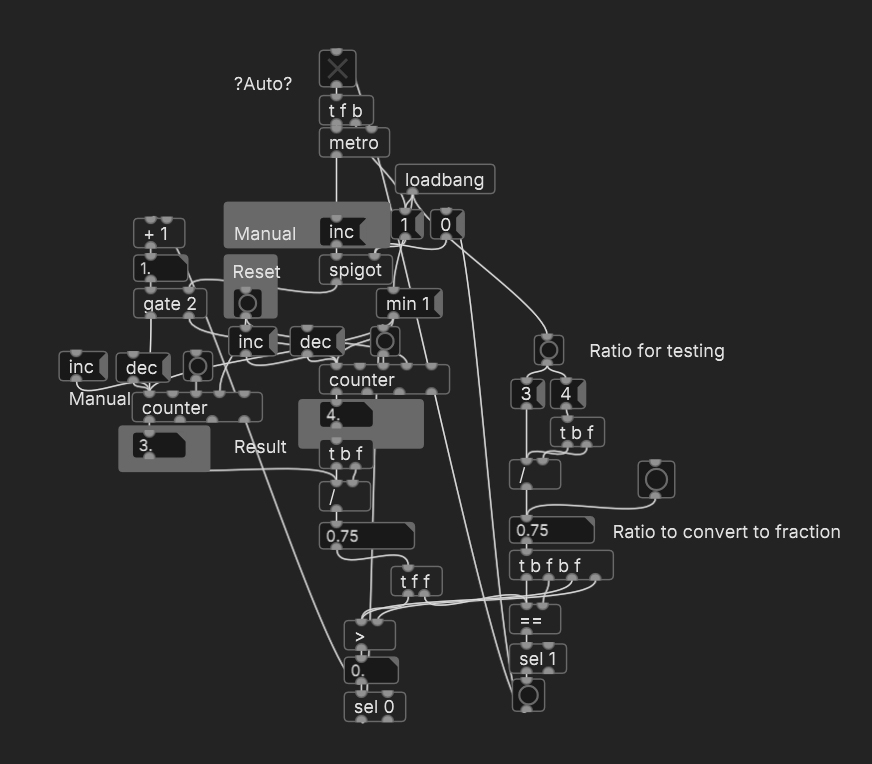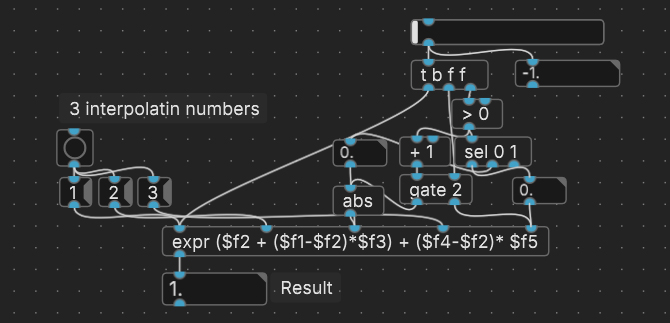-
 Aliam.Sigsaly
posted in patch~ • read more
Aliam.Sigsaly
posted in patch~ • read more@oid Have even dumber version
 - 6 instead of 9 object - 1/3 enhancement in brutalist/ minimalist matrix.]]
- 6 instead of 9 object - 1/3 enhancement in brutalist/ minimalist matrix.]] 
Interpolation-scale.pd -
 Aliam.Sigsaly
posted in patch~ • read more
Aliam.Sigsaly
posted in patch~ • read more@oid: Thnx for patch.
Yea, u have to be right - Slider is more imprecise cause it is px based - and it is same in MAX, Pd, Plugdata,
I often use number box instead of slider to make more exact out.Have a good one.
-
 Aliam.Sigsaly
posted in technical issues • read more
Aliam.Sigsaly
posted in technical issues • read moreHi,
how can one do ratio approximation -- fraction from number? (need it for - well tempered - scale, that should also be used on time and modulation).
Some starting patch would be great, cause I did not find anything on web.It was once provided by Omar Misa on FB, but it got deleted.. it was small patch using prepend and based on simple logic, that u consequently setting numerator w 1-9 denominator, until it match/ is close .. cool was, that u can also set/ show deviation.. and ultimately set what deviation is acceptable or set it some categories..
Imo for musical purposes, u often don't need complex object/ object-patch/ open object (that is hard to follow without Ph.D. or having Pd as almost only instrument and not just one of sometimes over hundred plugins), but rather a simpler patch w/ explanation of logic behind it/ context (like on U-he, D16groups manuals).. so u can alter it to suit your needs.
Just my opinion.
..................................As a tribute to Omar I've shared patch - in patch section - using his interpolation technique and update it for 3 values.
Happy patching.

Edit: Ok, I am digging to it from scratch - I am now sure, that it will be one of the least eloquent patch on the planet heavily relying on brute force....
EDIT: As I ve said *- least eloquent patch is done..CounterFin.pd
Patch simply rise denominator,. When its fraction ratio is below numeric ratio, it increases numerator +1 and start rising denom. from 1 again...
Increment/Decrements - allow set +/- 1 manually in different part, giving some overview for ratios - specily those that are close by, helping build your scale or its function(s), can serve as modulation etc.It allows also easy set of deviation parameters, cause chances to find clear fraction from large ratio are pretty slim,

-
 Aliam.Sigsaly
posted in patch~ • read more
Aliam.Sigsaly
posted in patch~ • read moreHi.
this patch is rather for Plugdata, since Pd imo does not have gate, tough u can use else/router, which is the same.As a tribute to Omar I've shared a patch using his interpolation technique and update it on 3 values.
There was discussion on this topic on FB too (also deleted, tough) and consensus was, that value offset created when adding nother interpolation is caused by imprecision of slider. I found it is not EDIT "completely" true,
Slider in Plugdata is pretty precise.
It is - obviously - cause by leaving the smallest step value in previous approximation, which distorts the final result.
Solution is to send "0" to not used part, when interpolating other value..
EDIT: *Tough as mentioned, despite 6 digits are pretty fine (enough for DIY fine-tuning in DAW, without noticeable side-fxs. W/out this there was offset even 1/3 of step - 0.02-4 cca, now it is in 0.5 Hz range - beyond vst synth resolution), but this is definitely not the best suited approach for 12 decimals scala-like Pro fine-tuning etc.. that wont flyBTW there should be probably even more elaborate solution, for more values - like using append+scale... if someone would like to beat the efficiency (make it dumber)) contest..

Happy patching.
Scale version is - obviously - in comments sesction..
-
 Aliam.Sigsaly
posted in news • read more
Aliam.Sigsaly
posted in news • read more@ddw_music There are tons of examples in installed folder now - they are probably based on what 60Hz did.
Learning it would help user get familiar w/ PD_Lua which is now also a bit better documented and w/ some useful examples, but it is a q how many people would go into such an endeavor..
It could tough make more sense for those musics oriented that those doing visuals.. we will never know..
..
EDIT: As far as I can say beside this great news I also feel like scripting in Plugdata got a bit backward trend and I would be now not just mildly upset if Lua curve won't be added into Pd_Lua as promised and Lua lib won't receive some attention which Imo deserves. -
 Aliam.Sigsaly
posted in news • read more
Aliam.Sigsaly
posted in news • read moreHi,
I ve heard rumors on FB group from 60Hz, that Ofelia is stop being developed.
This may be one of the reasons (next to better docs and more devices etc.) why in new Plugdata beta version GEM replaced Ofelia and allegedly can also be used in vst version (Ofelia was grounded to Stand Alone version).But what are your thoughts about it?
EDIT: Since it is now officially confirmed, just wanted to add that despite it takes a bit of free lunch from those familiar with Pd_Lua and those learning Ofelia were - let be honest - simply screwed
 Beside some particular cons/ pros which now does not have much sense to lament about, it is generally ABSOLUTELY FANTASTIC massive leap forward and Imo biggest milestone in already breathtaking speed of Plugdata development.
Beside some particular cons/ pros which now does not have much sense to lament about, it is generally ABSOLUTELY FANTASTIC massive leap forward and Imo biggest milestone in already breathtaking speed of Plugdata development. -
 Aliam.Sigsaly
posted in technical issues • read more
Aliam.Sigsaly
posted in technical issues • read more@whale-av I found the solution - it is really tough very elaborated hacking process> u have to open Pure Data first and then Plugdata.
 I think u ve been mentioning this may be one of issues..
I think u ve been mentioning this may be one of issues..
2024-03-12 11-40-08.mp4 -
 Aliam.Sigsaly
posted in technical issues • read more
Aliam.Sigsaly
posted in technical issues • read more@whale-av Yep, as u can see in last vid, it crash without console msg.
I think divide 0 detection is from Phase offset that is then divided by 2 to convert it to Radian. It can be solved giving it start on 2.
.
But thx for logical q. I want to display trace of XYz trajectory of modulation signal in Pd Ofelia, while be able to use Plugdata inside DAW and use synths like Zebra HZ...
Ofelia in Plugdata is still not finished (and is only for Stand Alone version anyway) so as temporary solution I wanted to use Pure Data.
It should be already piece of cake w/ [of.Window] object. I ve seen in Python code for and it was just one line command.EDDIT: What the do you mean by audio Pin? I have Steinberg soundcard, but how does it matter?

